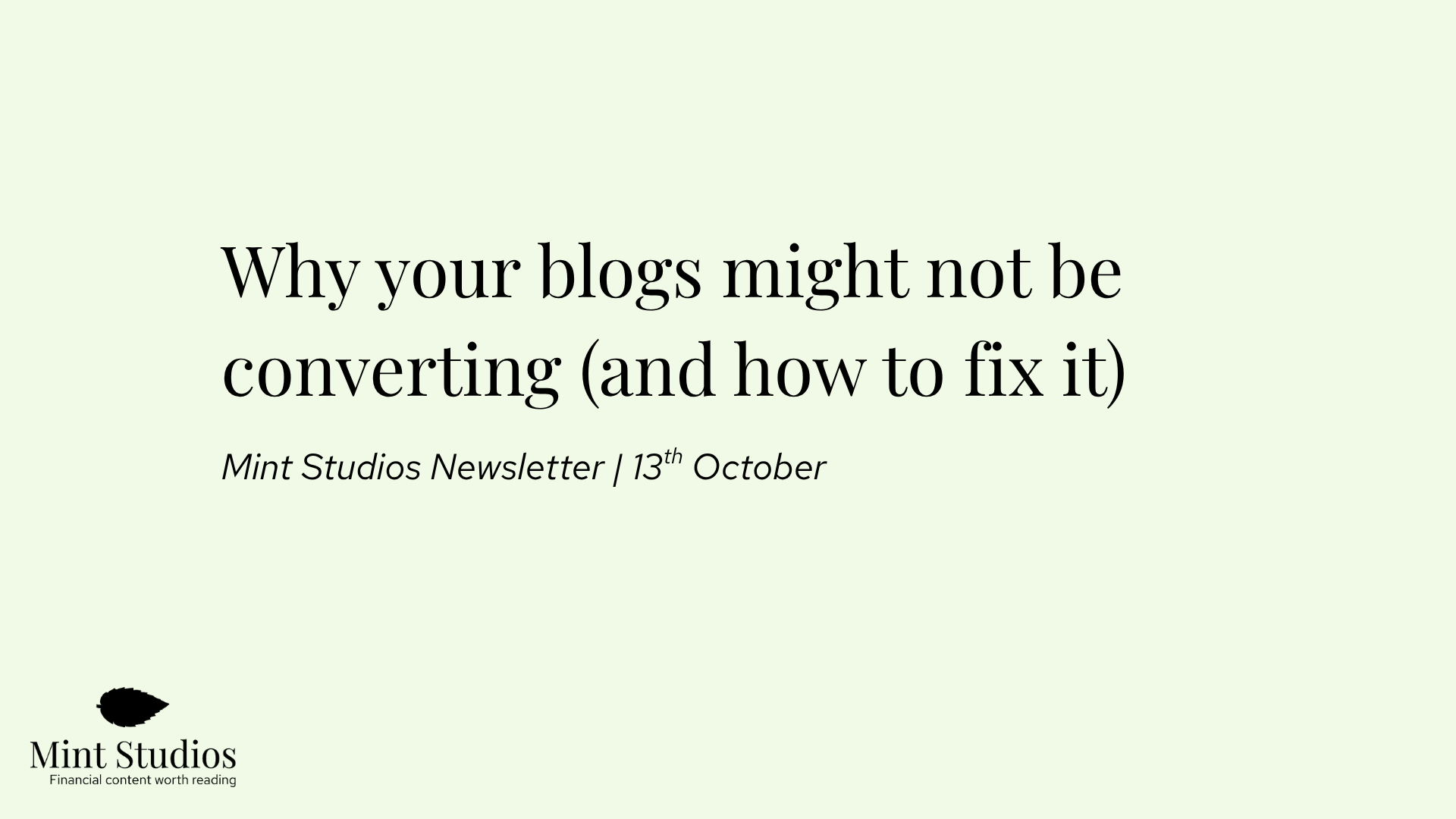As a content marketing agency that specializes in the fintech and financial services sector, we’ve written about a whole host of financial topics, including invoice financing, fraud, car financing, compliance, accounting and a lot more.
One topic we’ve written quite a lot about is payments. And because few content agencies write about payments, payment companies regularly come to us with content support due to our existing experience.
Interestingly, of all the financial services topics we write about, we’ve noticed payments is a rather unique industry to write about. As we’ll explore in this article, this uniqueness makes payments harder to write about than, say, invoice financing.
Payments is difficult to write about for a few reasons, but the main one is that payments are abstract and have a lot of moving parts, which can make it tricky to understand as well as explain. Another is that payments content is typically targeting a reader who is technical but thinking about things commercially (i.e. a Head of Revenue rather than a Software Developer). And there are more.
We’ve now written about payments for quite a few years now. Specifically, over 80 articles for clients like Modulr, Zai, Vyne, Fiska, Pomelo Pay, and more. We’ve also trained multiple members of our team to write about payments.
We’ve also noticed that very few agencies and content freelancers have experience writing about payments, which we believe explains why a lot of payments content is surface-level and only touches on beginner topics.
In this article, we wanted to share what we’ve learnt over the years of writing about payments and share some tips on how to write about the topic in a way that raises awareness of your product, educates the market, and most importantly, brings in customers.
We’ll cover:
- Key challenges when writing about payments
- How do you write great payments content? 8 tips
- Base your content on an interview with a product AND salesperson (or product marketer)
- Use a lot of examples, case studies and diagrams
- Use the [verb + feature + benefit/pain point] structure to ensure the benefits are very clear
- Remember, your writing doesn’t have to be “fun” to read
- Keep a document of key words and phrases to use throughout your content (even better, build out an educational resources)
- Make sure to write about the product
- Being specific is very important
- Don’t use typical “briefs”, use something more collaborative
Note: want to get updated every time we publish a new article? Join the newsletter we send every 2 weeks!
Key challenges when writing about payments
It’s abstract, difficult to visualise and involves a lot of moving parts
As mentioned earlier, a big reason payments are hard to write about is because the topics are abstract. APIs, card issuing, and reconciliation are all processes and technology you can’t really touch (except the payment terminals themselves). Not only are all these processes quite abstract, but they involve a lot of moving parts.
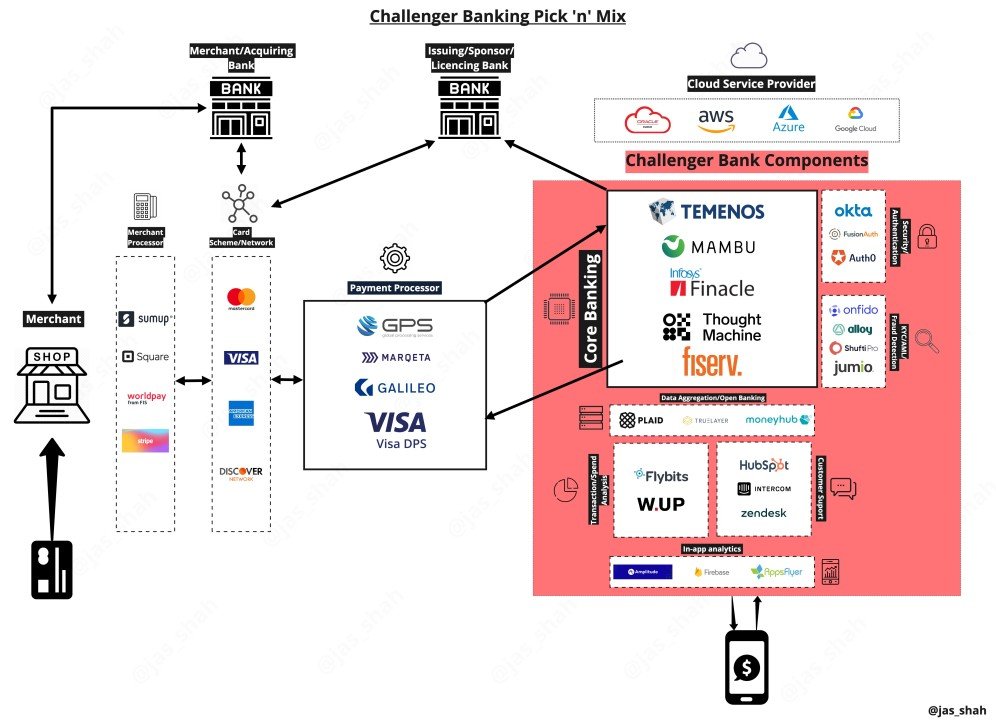
This is what differentiates writing about payments from writing about accounting software, invoice financing or banking. With accounting software, you’ve got the business, the accounting software and maybe an accountant or consultant. But with payments, you’ve got a complex network of relationships, including the merchant, the software, issuers, acquirers, card networks, and so on. It also doesn’t help that there’s a lot of jargon involved to help explain each process and player.
A combination of an abstract topic and a lot of moving parts makes payments hard to explain with just words. That’s why a lot of payment processes are often best explained with diagrams, flow charts, animations and videos.
But as we’ll see below, there are ways to write content that clearly explains how a specific payment process works and even using jargon to someone who is not familiar. It just means you have to be extra careful in how you explain something and make sure you understand it yourself before doing the writing.
Few people write about payments (well)
One of the biggest challenges we hear from the payment and financial services companies we work with is that people within their company don’t understand payments themselves. In fact, we’ve often found that we have a better understanding of payment processes than the marketing team at the payment company we’re working with.
This happens in any growing industry where few people, in general, are specialized in that industry. But the issue is if you don’t understand the topic yourself, it’s very hard to write a compelling article. Payments is not a topic where you can just use buzzwords and generalities – you need to be specific to clearly explain how your product adds value when compared to others in the industry.
Another issue is that there aren’t enough examples of great payments content. We regularly ask at conferences and events for people to share examples of a great piece of content on payments, and few people ever have an answer.
A combination of few people being specialized in payments and the lack of examples of great content makes it harder to attract and train new people to write about payments.
Payments content requires being able to write for a more advanced audience (and to find a balance between technical and commercial language)
Another complaint or challenge we hear from payment and financial services companies that come to us is that they’ve previously worked with a sector-agnostic content marketing agency, or a PR/SEO agency that also does content, and they’re not happy with the quality.
What they mean by quality, is that the content is typically quite beginner level. The titles sound like “Introduction to Direct Debits”, “Open Banking 101” and “Ultimate Guide to Embedded Finance”. And when you start reading it, it’s very surface-level, thought leadership, Chat-GPT like content. This typically happens because the agency or freelancer is likely new to the payments industry and learning on the go. It’s also because they don’t understand that when writing about payments, you’re usually targeting a more advanced audience, not a general mass audience.
When writing about payments, you are targeting readers who are technical and commercial at the same time. You’re writing for Heads of Payments, payment managers, product managers, Heads of Partnerships and commercial leads. Writing about how a payment API works to a product manager is very different to writing about an appointment scheduling tool to tech workers.
The people we are writing for are educated, intelligent, and typically have some understanding of payments already (this is why “write for a 5 year old” advice doesn’t apply here). They are not developers, and they’re not CEOs or high-level exec teams either. That means that in the content itself the writer needs to be able to keep a balance between being able to get into the technicalities of how a payment process works, but still be able to make it clear what the benefits of this process are from a commercial perspective.
From the hours we’ve spent training writers on our team, this is where we’ve seen the biggest slip-ups. Some writers believe that because it’s technical content, we just need to throw a bunch of buzzwords together into a sentence and the technical people will understand. Other writers simply don’t get technical enough, and that’s how we end up in a situation where every payments article is rehashed, regurgitated content from elsewhere. A rare few number of writers understand the fine balance between the two and love it because they are inherently curious. Those in the latter camp are those that succeed and great content.
This is why we believe strong writing and thinking skills are more important than having payments knowledge. Teaching someone about payments is easier than teaching someone how to write clearly (trust us, we’ve tried). In our experience, a writer will create great payments content if they are an inherently curious person who loves learning about new topics and is often excited to get into a technical topic like payments.
Payments is increasingly commoditized, so being able to write about product is especially important
The payments industry is pretty crowded. There are hundreds, and even thousands of embedded finance, embedded payments companies, all with different value props, features and benefits.
When a lot of commoditized companies produce a lot of content, you end up with commoditized content. It’s also why a lot of payment content looks the same. If you’re creating content to help position your company as a thought leader, to build trust, educate and acquire customers, then you need to make it clear how your product is different – and that’s even more important in a commoditized industry.
To create great payments content, the writer therefore needs to understand deeply how the product is different and adds value when compared to competitors. Doing this well requires strong product positioning, regular communication with the sales team and a deep understanding of payments and the product.
What we’re saying is that since a lot of payment companies look quite similar, the writer needs to be comfortable going into details about product features and benefits. In our experience, that’s a skillset that’s hard to find and few writers are able to do.
How do you write great payments content? Our 8 tips
These tips are for:
- Marketing leaders who have just hired an in-house content marketer or content writer who isn’t familiar with payments and will start producing marketing content.
- Content writers (freelancers or agencies) who have started working with a payments company as a client and want to create great content.
- Anyone else who works at or closely with payment companies and wants to be good at explaining certain terms or topics.
Although we’re known at Mint Studios for helping financial services companies create Bottom of the Funnel content that focuses on generating business results, these tips also apply to top of the funnel content, white papers, one sheets, and every type of content.
1. Base your content on an interview with a product AND salesperson (or product marketer)
Unless you’re an expert on your product or payments yourself, we highly recommend interviewing an expert for your content. We’ve explained why and how to do it here: Why You Should Create Content Based on Interviews With Experts
There are so many moving parts in writing about payments, that having an expert who lets you ask follow-up questions and make sure you can understand a specific payment process or feature is invaluable. We’ve found that three best roles for this are:
- Product
- Sales
- Product marketing
From our experience, the best person to interview is a product marketer, as they have a great understanding of the product as well as how to communicate it. But if they are new to the business or don’t have as in-depth an understanding of payments as you’d like, then a product manager and salesperson is the best combination.
We like to set up a recurring meeting with the primary expert (either a product or salesperson), and then consult the other expert when necessary. Once you’ve prepared your piece of content, pick one of them to agree to review it (having too many reviewers can slow down production a lot).
Why interview both a product person and a salesperson? In our experience, if you rely only on a product person, your content risks getting too technical and not being able to adequately explain the “why” of the feature. If you rely only on the salesperson, you risk not being able to get into the details that your audience often will want. Basing your content on both will allow you to go into the right level of detail while focusing on the features and benefits that matter to your reader.
We’re going to use a real example to showcase what this looks like in practice. In this article we wrote for Modulr we explain why Modulr’s EMI license is relevant for the reader (this article was based on an interview with a product person).
One of the key features Modulr offers is their EMI license. But why is that relevant? How does this benefit the client? This is a classic example of why it’s important to explain the commercial side of payments so that a feature is very clear. In this section, we explain what a Modulr client can do through their EMI license:
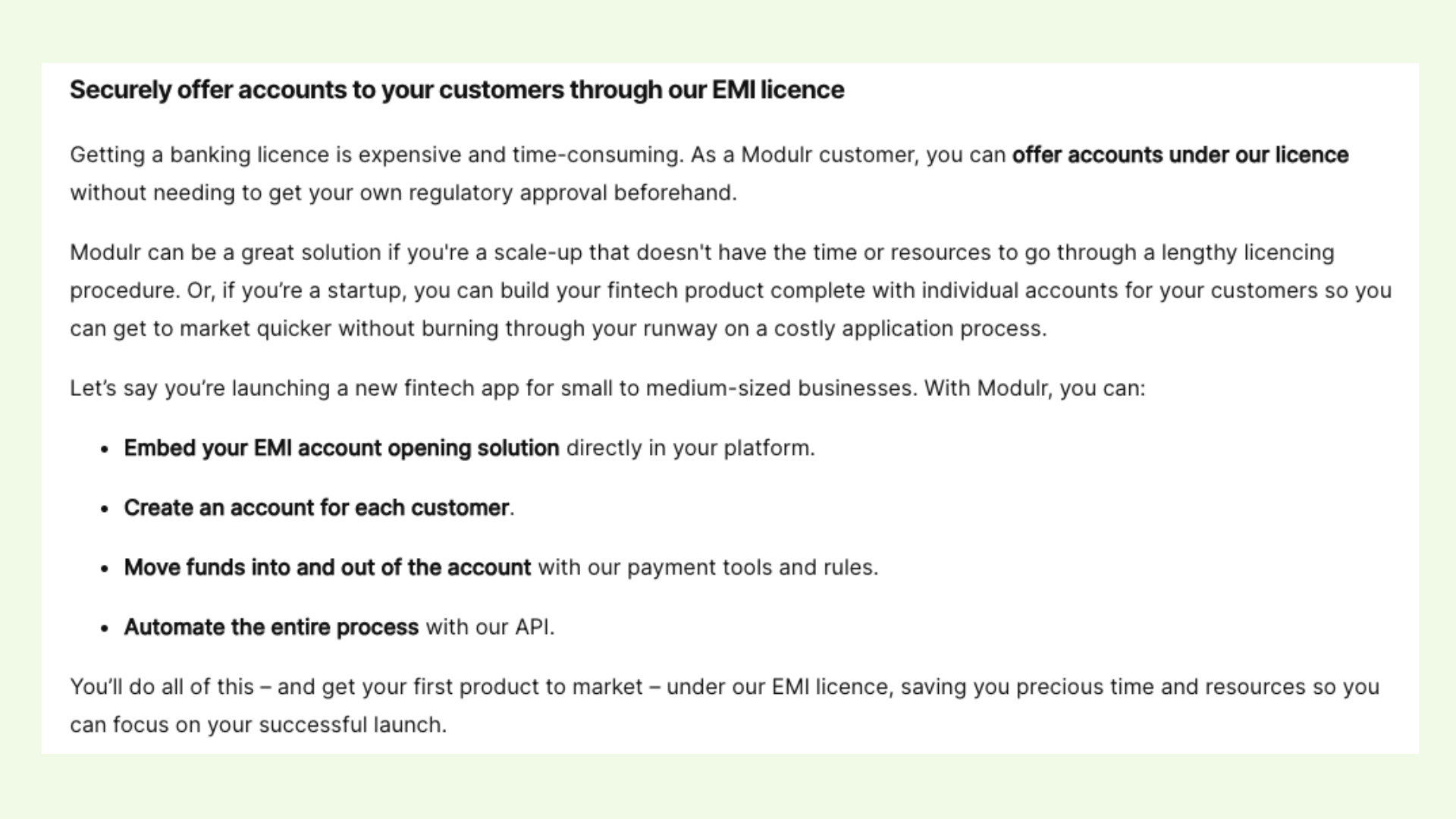
We’re not just saying “Here’s a great feature: you can use our EMI license”. We’re first touching on the pain point “getting your own banking license is expensive”, then highlighting the feature “use our license” and then the rest of the section focuses on what that means for them, the customer.
With the combination of input from a product and salesperson, we can go into more detail about specific features as well as explain how the benefit helps the reader. This helps make it clear to the reader how they would work with Modulr and what differentiates it from other solutions.
2. Use a lot of examples, case studies and diagrams
With an abstract topic like payments, the best way to explain specific features and benefits is to put them in context. Instead of just talking about how your API works, use an example of how a gig platform can use the API to split payments and push them instantly (for bonus points, use a real customer of yours to build credibility).
When we write a piece of content, we try to add as many examples as possible. The more the better!
Following on from the example above, even though we’ve gone through the benefits of using Modulr’s EMI license, it still might not be very clear what this looks like in practice and what that ultimate benefit to the company is. So we explain it with an example:
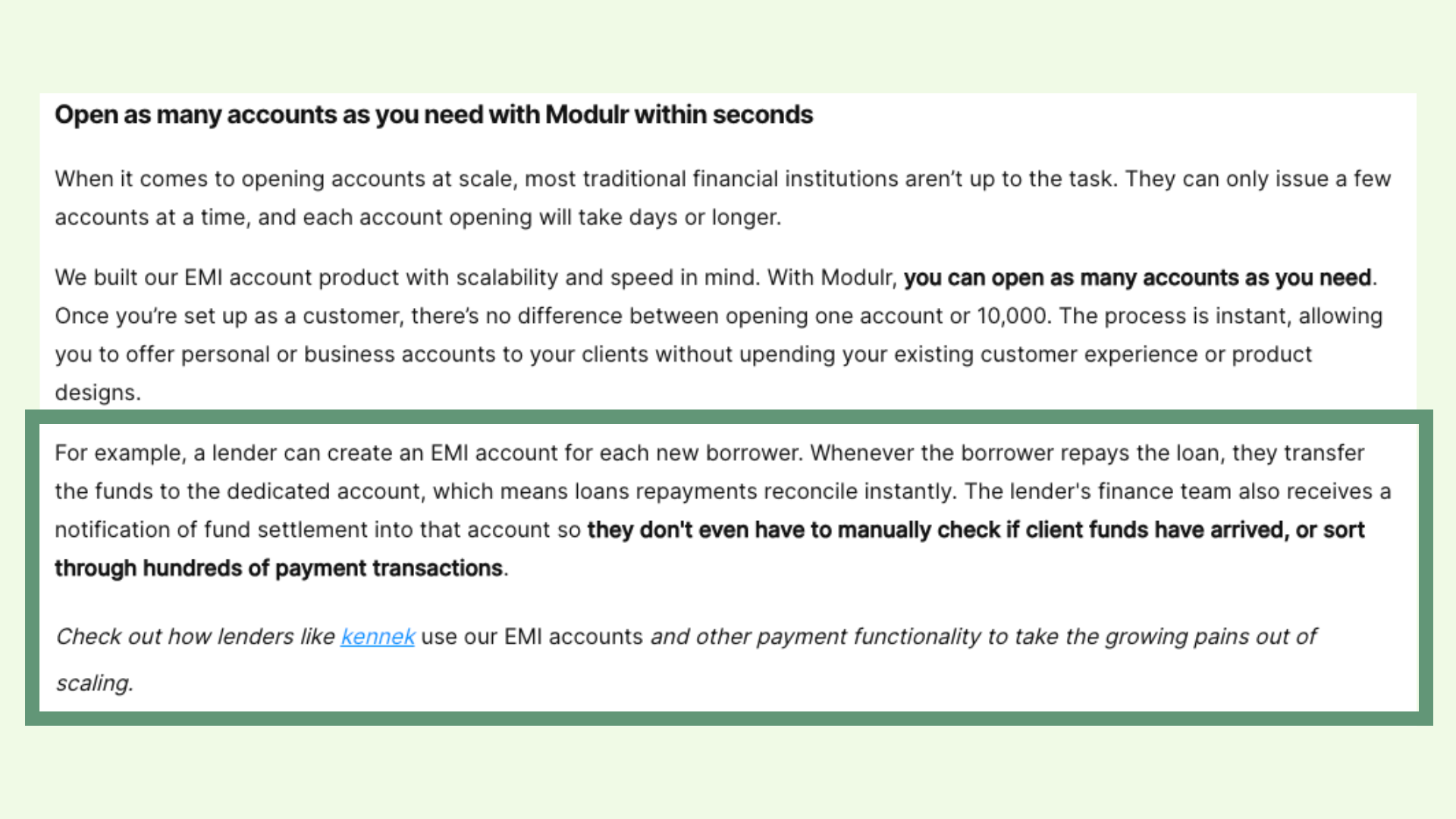
We then add a link to a case study to make sure it’s super clear. See how with a real life example it’s a lot easier to understand how “unlimited EMI accounts'' can benefit a business?
Within that article, there are 5 mini examples or case studies to explain, and that’s excluding the “What industries can benefit” section which uses examples to explain how various industries benefit from EMI accounts.
This is why we highly recommend not to use just one example, but to pepper multiple throughout your content.
As mentioned earlier, we also really like using graphs and images. Explaining a payments concept can take 200 words to explain, but a well designed graph could communicate the same concept in 5 seconds.
Take the feature of split payments. It can be hard to explain how this works in words: when a payment is made, a percentage will be calculated by each party which then needs to be sent to each party. This is where a diagram or an animation can really make a point clearer. In this article for our former client Zai, we added a diagram to explain how split payments worked with a marketplace:
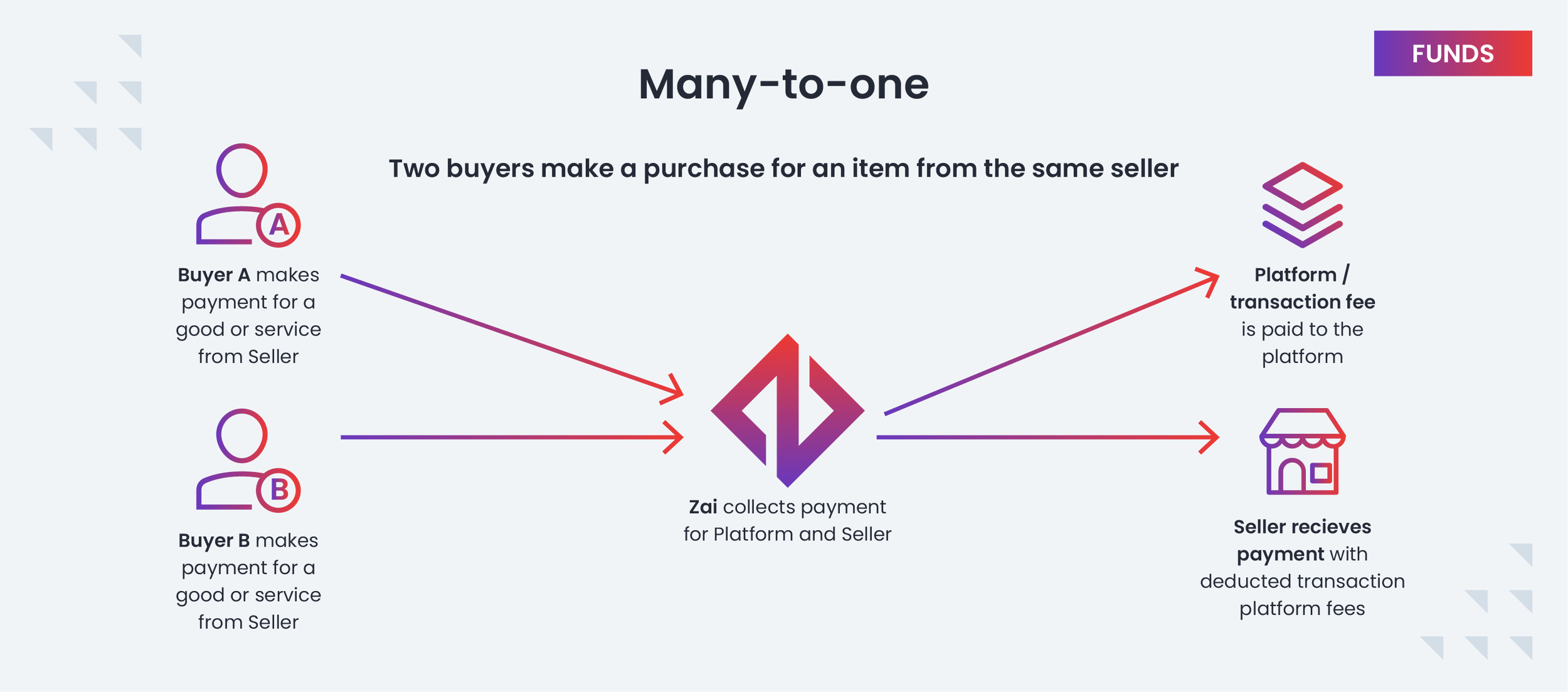

With these diagrams, you can immediately see how cumbersome it would be to do all these calculations manually – and why it makes so much sense to use an API to do it.
Don’t shy away from adding diagrams and animations in your content. Even a very basic diagram that you put together in Canva with your branded words can make things 10x clearer.
3. Use the [verb + feature + benefit/pain point] structure to ensure the benefits are very clear
One of the main issues we’ve found when writing about payments is that it’s easy to list many features to make a solution sound amazing. But as we’ve said before, that’s a good way to commoditize your product and leave the reader more confused than before. For a Head of Payments or product manager to be very clear on how your features can help them, you need to go further than just features.
Our content strategist, Michelle Maiellaro, came up with a structure that she uses together with our writers to better guide the writer to ensure they talk about benefits clearly:
- Subheading title: Action verb + feature + benefit (or pain point resolution)
- Subheading body:
- What is the feature and what pain point does it solve for
- How does the feature solve the pain point (if not already mentioned at the beginning) and what are the benefits and advantages
- Give an example/use case to bring your point home
It may come across as very rigid, but you can see this more as a framework than a strict script to follow. Also, as we’ll see below, it’s important to remember that the Heads of Payments we’re writing for often prefer this style of writing than fluff or the classic “thought leadership” approach.
See an example here in another article we wrote for Modulr, on SEPA API, written by one of writers:

Compare this clearer, structured approach to a more generalist writing from a different payment company that just focuses on features:

Which is clearer?
In the second example, we get a sense that there’s a lot we can do by working with this company. But in the first example, we get more: we get a clear understanding of how this feature will help us. With Modulr, we understand that funds will transfer in under 10 seconds, or the next business day if the bank doesn’t support SEPA Instant Credit, which is an absolute game changer for many businesses (especially in the earned wage access sector).
You could argue that we could have gone a step further and explained why fast settlements can help the business’ bottom line. We do go into how a SEPA API can help various sectors down below:
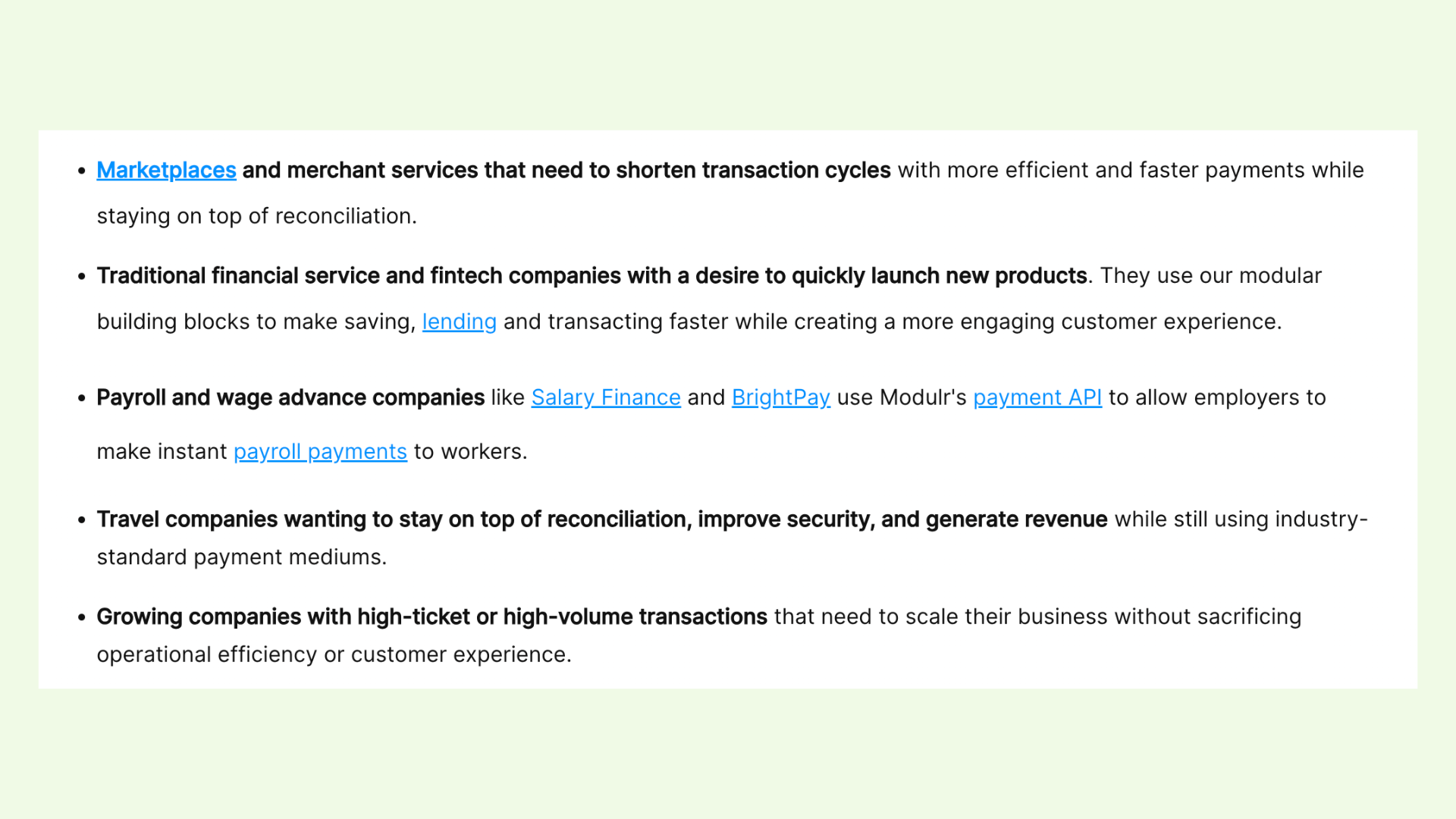
Following a framework like this ensures that you always make sure the benefit or the pain point you solve is very clear to the reader, and don’t fall into the trap of just listing features. If you’re a strategist or marketer working closely with a writer, we’ve found asking your writers to follow this structure really helps them make sure they’re communicating your features and benefits clearly.
4. Remember, your writing doesn’t have to be “fun” to read
There is a huge misconception in payments or anything B2B that your content has to “tell a story”, “hook the reader” and “be entertaining”.
That may apply to content about health, parenting or gardening, but writing for a B2B payments audience is very different. The main reason? Few people are reading this for fun. They’re reading it because they need to make a decision – either now, or later down the line.
With content about payments, we also have to remember that we are writing for a buyer committee. That committee will likely comprise the decision maker, the operators (e.g. financial controllers), integrators and others. Although the decision maker might not be the one doing the research, there will definitely be someone on that team that is doing research.
Katarina Nording, SVP of Marketing and Revenue at Adyen, shared the approach Adyen takes to doing content for a buyer committee with us in a recent interview: How Financial (Technology) Companies Do Content: Adyen’s Content that Sells to Enterprise
What’s important to remember is that the person doing research needs this information to make an educated, careful decision on which provider to choose according to their payments strategy. They’ll then put together a shortlist and then reach out to the ones they feel are the best fit.
This is a process that takes months, and the researcher needs to feel that they have a good understanding of what the provider does. This is not an impulse purchase.
That’s why the priority in your content is to clearly communicate how your product is different and adds value – it doesn’t have to be “fun”. The examples we’ve shared so far may come across a bit dry – but that’s fine. Would you rather read something dry but clear, or something fluffy that doesn’t teach you anything new?
Here’s a good analogy to get yourself in the mindset of the reader: think of the last time you were cooking a meal and looking for a recipe. You probably wanted the recipe as soon as possible, and got frustrated when the author spent two thirds of the articles writing about the backstory of their recipe. You just wanted the information so you could get on with your day.
That’s the type of person you’re targeting with your content. Someone who just wants the right information, communicated clearly. They don’t need to be “taken on a journey”.
Dan Whale, a copywriter with many years of writing about payments, says this as well:
“There’s an uncomfortable balancing act when it comes to writing about payments. Your audience is highly unlikely to be interested in what you’re saying - all businesses need payments but not many will get excited by the intricacies of financial processing. It’s a necessary afterthought.
Therefore it might be tempting to combat that by being fun and playful with your tone, perhaps even throwing a few jokes in. That won’t work either, because people don’t want their payment provider to be funny - they want them to be trustworthy and reliable.
So what do you do? I’d say just get to the point as quickly and accessibly as possible. They’re almost definitely going to need a face-to-face conversation anyway, just give them the core aspects so they want to reach out.
Finally, don’t underestimate how much your own perception of what is comprehensible has already been warped. When you’re around a product or service every day, your brain is going to assume certain things are obvious - but they won’t be to most people. Read it to a friend or spouse and see if they get it.”
5. Keep a document of key words and phrases to use throughout your content (even better, build out an educational resource)
Something else we’ve seen when working with multiple payment companies is that each company has a very particular way to describe things. Some prefer “embedded finance”, others prefer “payments as a service” while others stick to “embedded payments”. This is part of the positioning, sales and marketing material and key to how you communicate how your product works.
We’ve found that people tend to spend too much time building a “style guide”, where you talk about grammar mistakes or whether you use the Oxford comma. Sure, that’s important, but where you put the apostrophe is less important than the actual content. If you say you offer “banking services” instead of “payment initiation services”, that’s a much worse offense (especially in payments). That’s why it’s important to first focus on ensuring the actual content is good.
Compliance is also important here, so you need to work closely with the compliance team to agree on which phrases to use, as well as with the sales team. Since using the right words is so important, you want to have a strong QA or review process when creating your content so you keep all of this to account.
We use a simple Notion document, but anything else like Confluence can work:
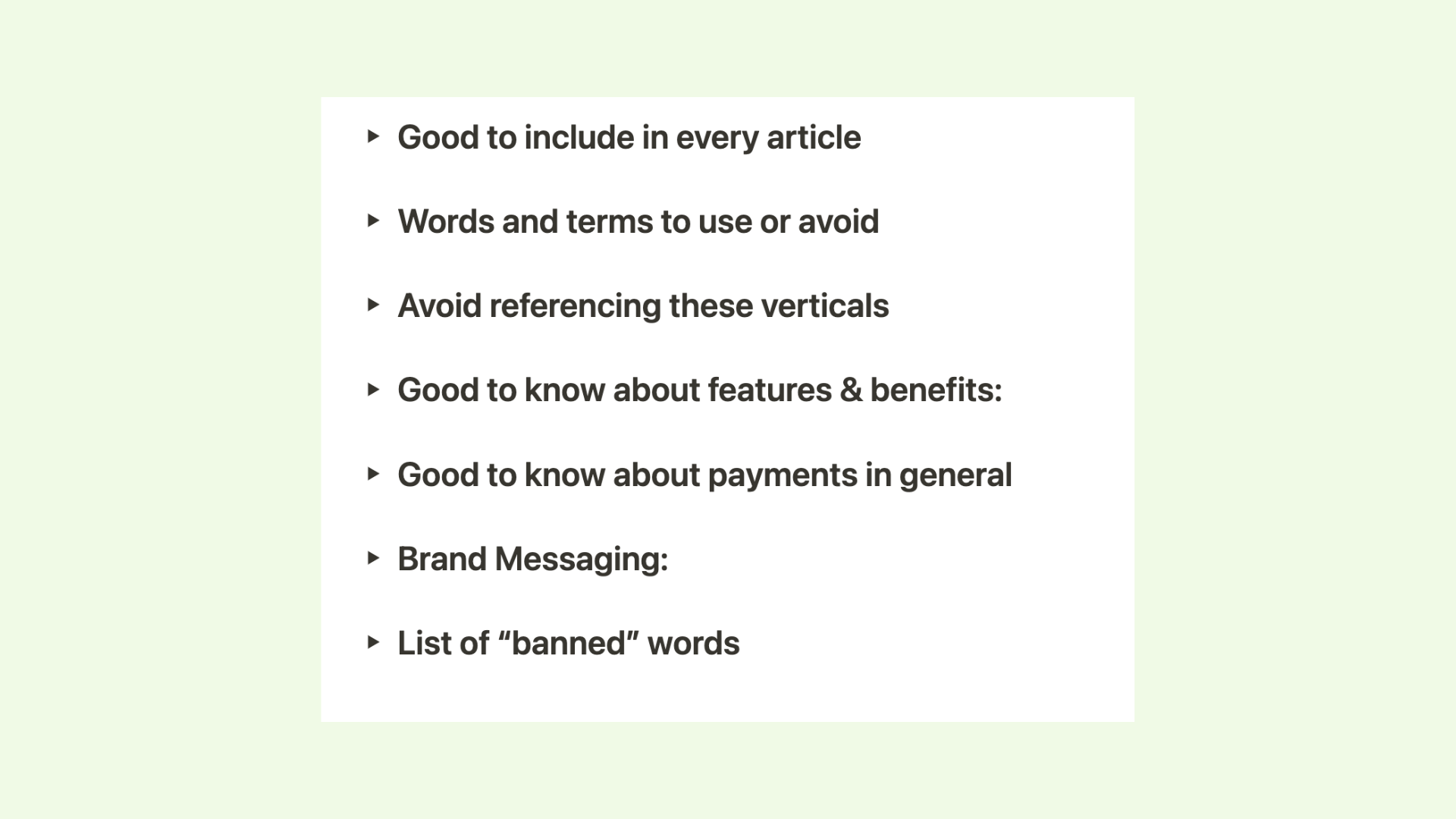
Since payments can get complex, we also recommend building out a more educational resource for people who are new to your company and to your product. For example, we have a page with a product’s key features and benefits, which we can quickly refer to when writing a new piece.
Don’t be afraid to take information from developer docs
Another tip from our content strategist, Michelle Maiellaro:
In some cases, where a payment company's developer API guides and reference docs are well written and easy to understand, both your strategist and writer can use these to get a better overview on how the company’s products and services work together.
These guides are a treasure trove for helping you connect the dots where some of the technical aspects may escape you during your interviews, raise further questions to ask during future interviews to deepen your product knowledge, and even shed light on some important topics and keywords you may have missed in your initial research.
In fact, we’ve seen that it’s not just developers who are researching API-related keywords. There are also product people and heads of product searching for an interface to solve a technical aspect that will often help them optimize their main products. This means there’s not just informational intent but buying intent, which is why we’ve been able to rank alongside (and above) developer docs with these topics and bring in leads and closed deals with that content.

The important thing with these articles is to get to the point quickly, explaining briefly how this company’s particular API works, then dive into the specific features and benefits of their API, which can be vastly different from one company to the next.
As we can see in the Zai article, when a company uses Zai’s API, not only will they get a way to automatically split payments between multiple parties instantly, but that integration allows them to tap into a host of additional benefits such being able to create new users quickly. These benefits are not clear unless you point them out in your content.
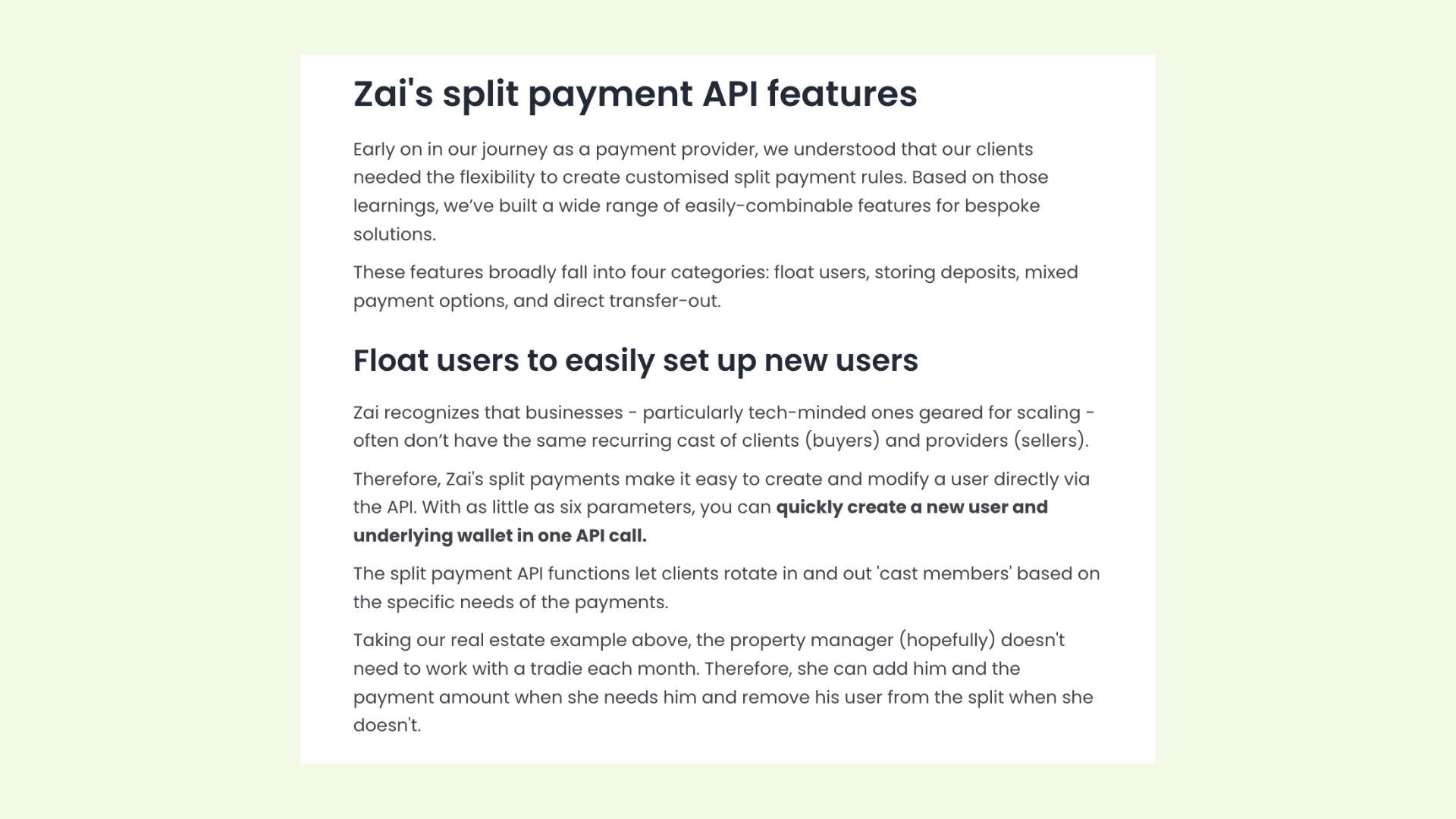
6. Make sure to write about the product
One thing you may have noticed in the examples we’ve added in this article is that we’re often talking a lot about the product.
In our experience, marketers are often uncomfortable with writing about the product as they don’t want to come across as salesy. It’s a totally understandable reason, however, we’ve found that in payments you need to be able to talk about the product. The main reason is the challenge that we wrote about earlier on: the payments industry is very commoditized. Why should the reader read your article on “How Open Banking payments is changing the retail landscape”?, if everyone else is writing the same thing?
The other reason is that if you’re writing for product managers, they’re going to want to learn the details about how your product works – they’re entire job focuses on that.
We believe this is a big reason a lot of payment content is very similar and doesn’t stand out – a lot of writers aren’t comfortable going into detail about the product (or, they simply can’t write about the product because they are too removed from the company or don’t understand payments, but that’s a separate issue).
If you want to create a piece of content for your payment company that stands out and successfully positions you as an expert, you need to be willing to write about the product. In a world where too few people can write in-depth about payments, talking about your product in detail and in a clear way helps establish credibility and shows that you know what you’re talking about.
And what’s important here is: you can write about your product in a way that is not salesy.
Compare these two articles:
- Benefits of Multiple Payment Options for Businesses | GoCardless
- Multi-options payments: How to add them seamlessly with Zai
In the article written by GoCardless, we get a good overview of why it’s worth offering different payment methods – and that’s pretty much it. (As an aside, we generally like GoCardless’ content for people who are new to payments).

But it’s quite surface level. If you’re targeting a product manager, they probably already know the reasons to offer different payment methods. Instead, they’re probably more interested in how setting up a new payment method with GoCardless will help maximize conversions. Anyone can say they maximize conversions – but how does GoCardless do it? What processes do they have that allow them to promise that?
Although the article has a demo on loop which looks great, it only showcases how to collect direct debits with GoCardless and doesn’t make it clear how this helps with conversions, minimizing abandoned carts and enhancing brand perception.
Contrast this with the article we wrote for Zai on multi-option payments. In this article, we decided that the best way to explain something complex like how to accept multiple payment methods and the benefits of doing so, is by explaining it via the product.
First of all, we actually list out the payment methods the customer can implement, while making the benefits of each payment method clear as well:

And then when we go into detail about Zai’s key features and benefits, we explain how the customer can access multiple payment options via Zai’s RESTful APIs, and the benefit of that:
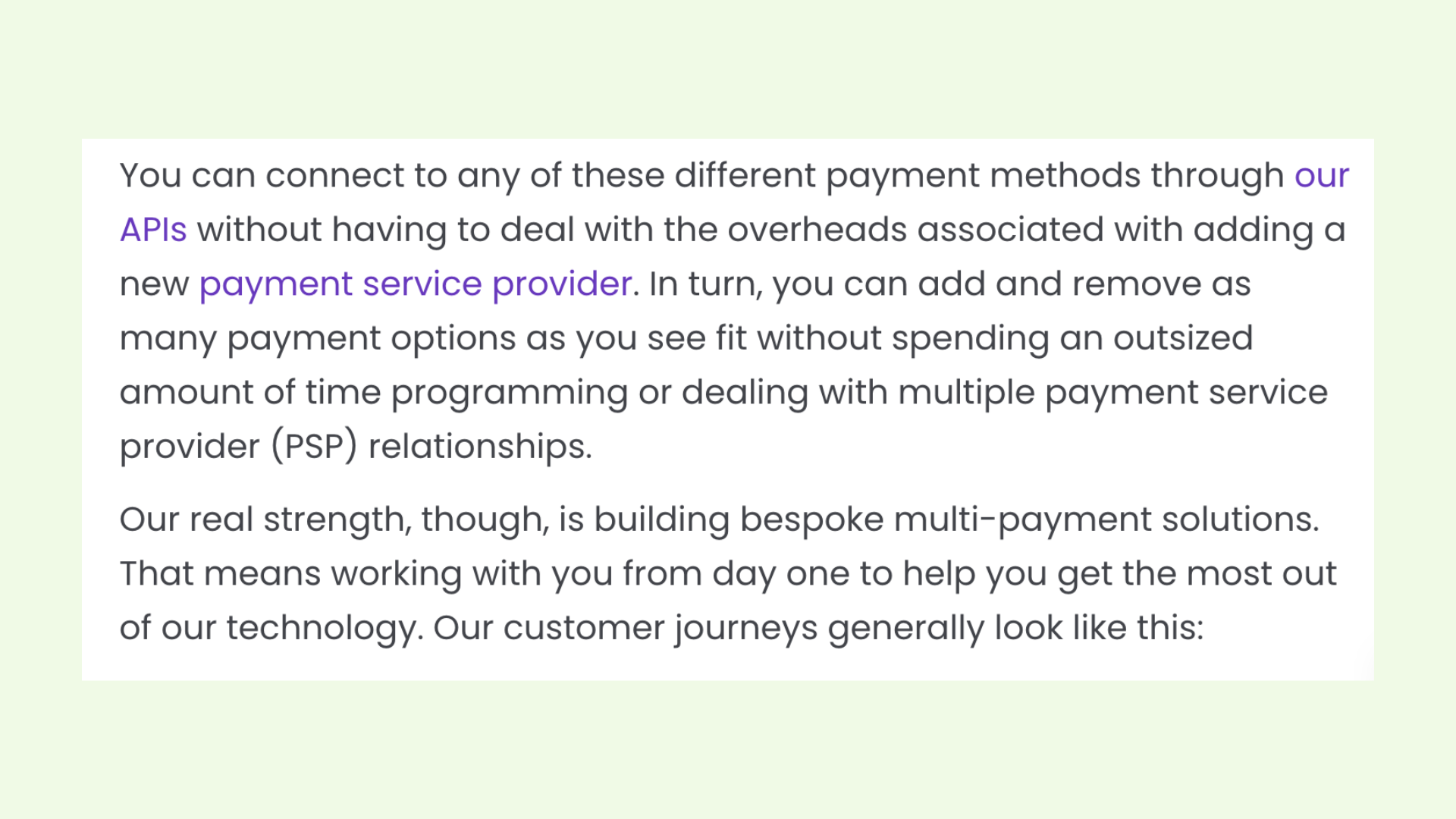
We can assume that the reader already understands the general benefits of adding multiple payment options and is more interested in the benefits of using Zai specifically.
We even go further in this article by explaining the key mistakes they should avoid:
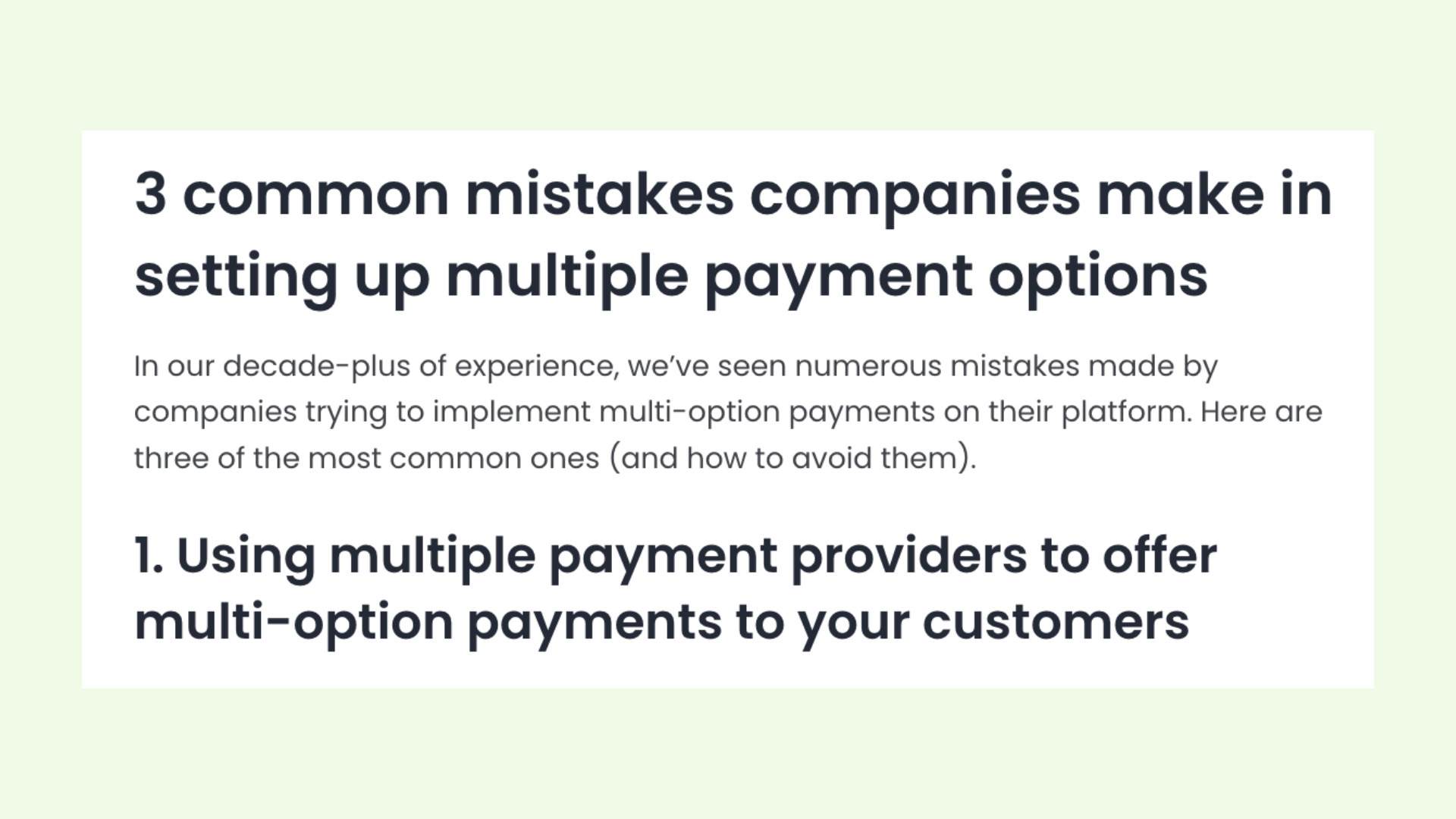
Based on these two articles, one by GoCardless and one by Zai, which one do you think will leave the reader thinking “I understand better the benefits of multi-payment options.” If we’re targeting a more advanced audience like product managers, we would say Zai. If we’re targeting absolute beginners, yes, perhaps GoCardless is better.
But when selling to a more advanced buyer, you’ll be dealing with a buying committee that shortlists the various payment providers to talk to and have some more questions about implementation. In that case, it’s very likely they’ll reach out to Zai since the piece of content we created is clearly targeting them and got into the level of detail they were hoping for. The article also did a good job of differentiating Zai from competitors, which makes it clearer how they add value.
This is especially helpful in more saturated markets like Open Banking, identity verification or Banking as a Service. And yet, a lot of these companies never mention their product in their content. How is the reader supposed to know whether they should pick your company over someone else?
We go into more detail about how to write about product here: How to Write About Your Product In Your Content [And Increase Conversions]
7. Prioritise wording that is specific
Because payments are abstract, there’s a lot of moving parts and the topics can be complex to understand, it’s even more important to be specific. We have a list of “banned words” that we try to avoid when writing, and they include words like:
- Seamless
- Streamlined
- Synergy
- Holistic
- Unleash
- And many more
It’s easy with payments to just constantly say “operational efficiency”. But what does that mean exactly? What type of operational efficiency – does that mean payment speed, automated reconciliation or other? And how does the product achieve this?
Typically, writers use words like these when they don’t understand the product/feature well enough, and so these buzzwords are used almost as band-aid.
But again, if you want your content to stand out, for your prospects to truly understand your value add and to build trust, you instead need your writers to be willing to go beyond using buzzwords and instead spend the time truly explaining how the feature leads to that benefit.
It’s difficult. It requires working with a writer who is willing to go the extra mile, who is inherently curious and can understand payments. This is why it’s so hard to find good content about payments: good content is generally hard to find, so something even more niche like payment content, is even harder to find.
If you’re editing or training a writer to write about payments, make sure you give them as many resources necessary (a one page document on “personas” is not enough), access to your salespeople and marketing material. And make it clear that specificity is important.
8. Don’t use typical “briefs”, use something more collaborative
To continue on from the last tip, we believe that a lot of content falls flat because the process content strategists or marketers use to collaborate with writers itself isn’t great.
A lot of content is produced using the typical “content brief” approach. This is where a strategist puts together a summary of what type of content is required:
- What we’re writing about
- Headers to include
- Word count
- Keywords to include
- Etc.
They may look something like this:
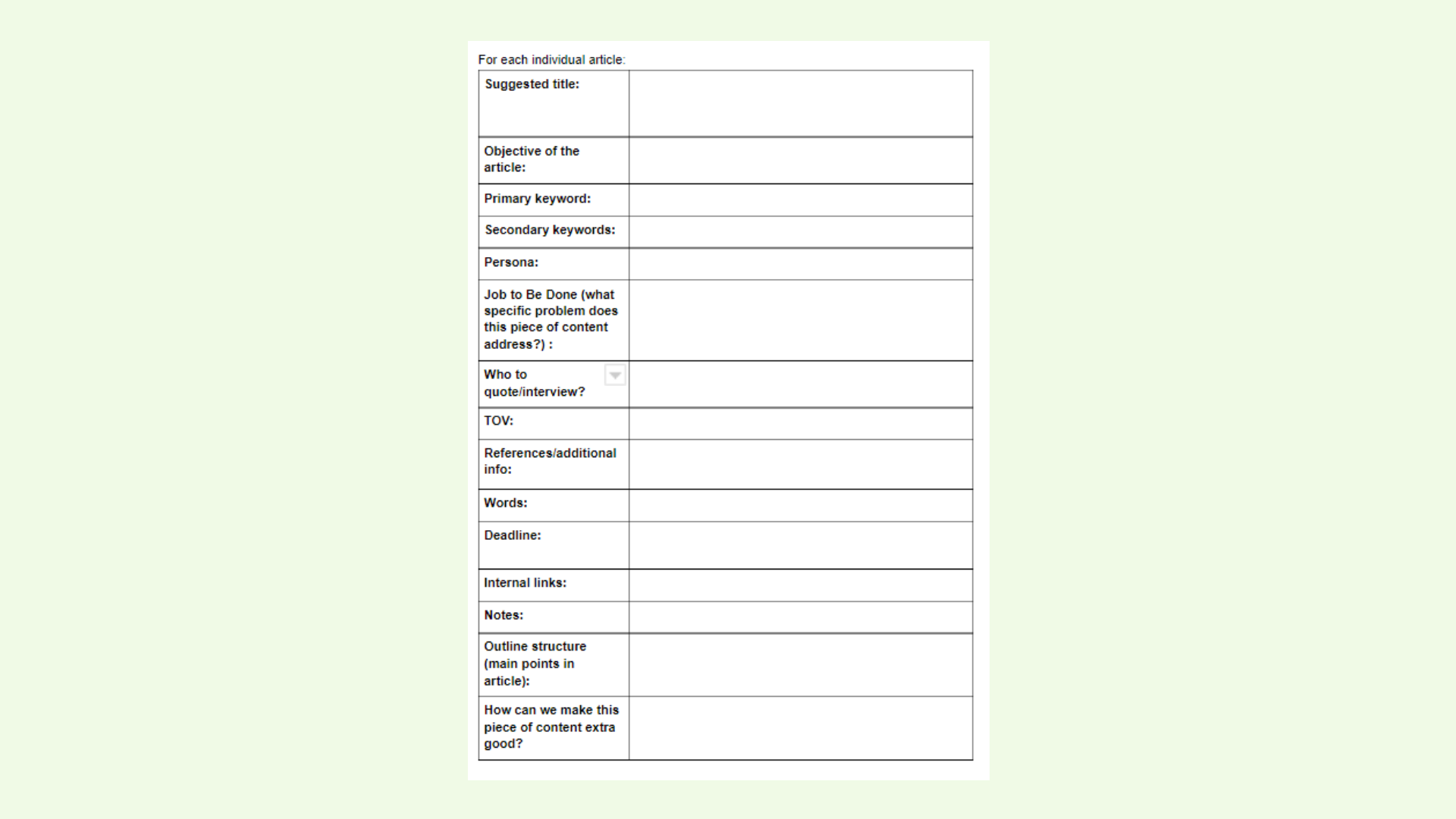
Some content briefs are five pages long! They’ll include details on how to write bullet points, where the writer should do their research, what links to include, and so much more.
Everything except what is most important: the message we’re trying to share.
We’re not fans of the content brief, because we believe it puts too much emphasis on what we believe are details, and not what is the most important: does this article speak to reader pain points? Are we including the right features and benefits? Does the argument we’re making make sense?
In order to get the message right, the writer and strategist have to be in close collaboration to ensure the argument makes sense, the supporting points are there and the right examples are used. That can only be done well if the writer also has a say on who the article is targeting, what pain points to focus on and how to explain the product. And this only works if the writer has a deep understanding of who they’re targeting – which is why outsourcing to a freelance writer rarely leads to in-depth, product content.
We prefer a different approach, where we use a questionnaire: the writer is required to come up with pain points, features and benefits to target, the strategist approves it, and then they write the content. The writer is also someone who works with the company long-term, and takes the time to understand the product, market and customers pain points.
If you’re interested in seeing the questionnaire we use, you can download it here:
Good payments content requires clear writing, inherent curiosity and not being afraid of getting into the technical details
Writing about payments is not easy: you need to be willing to spend extra time watching the Youtube videos, designing the graphics and chasing your product person for an interview. And yet, interestingly, our team loves creating this content, because they are inherently curious.
This is what we believe is key to creating great payments content: the person doing the writing has to be inherently curious about how payments work. If not, they will never be motivated to truly understand the difference between ISOs and Payfacs, how interchange works and what an EMI license is – and therefore be motivated to create compelling content.
That’s the killer combo for a great payments writer: inherent curiosity combined with clear thinking and an ability to get into product details. If you know someone who is like that but is new to payments, then they’ll do well – feel free to share this article with them so they have some tips to get them started.
We hope these tips were useful. If you liked them, let us know and we’ll consider putting together a part 2!









